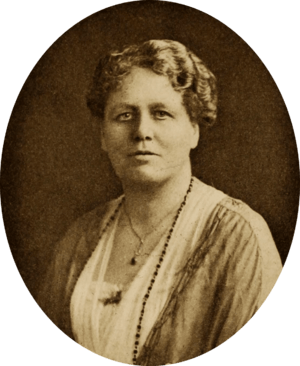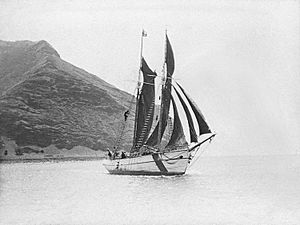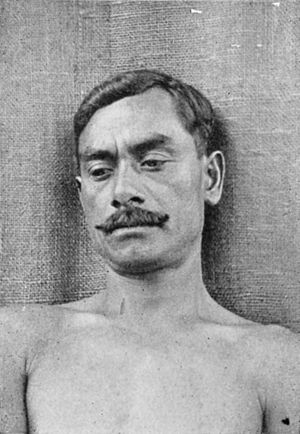Katherine Routledge facts for kids
Quick facts for kids
Katherine Maria Routledge
|
|
|---|---|
 |
|
| Born | August 11, 1866 |
| Died | December 13, 1935 (aged 69) Ticehurst, England
|
| Nationality | British |
| Alma mater | Somerville College, Oxford |
| Scientific career | |
| Fields | Archeology |
Katherine Maria Routledge (born August 11, 1866 – died December 13, 1935) was an English archaeologist and anthropologist. She is famous for leading the first major study of Easter Island in 1914. Her work helped us understand the island's ancient culture.
Katherine was the second child of Kate and Gurney Pease. She grew up in a wealthy Quaker family in Darlington, England. In 1895, she graduated from Somerville Hall (now Somerville College, Oxford) with honors in Modern History. She later taught courses for a while.
After the Second Boer War, she traveled to South Africa. She helped investigate how single working women from England could resettle there. In 1906, she married William Scoresby Routledge. They lived among the Kikuyu people in what was then British East Africa. In 1910, they published a book about their research called With A Prehistoric People.
Contents
Exploring Easter Island
In 1910, the Routledges decided to organize their own trip to Easter Island, also known as Rapa Nui. They had a special ship built, a 90-foot-long Schooner named Mana. This ship was very modern for its time.
They teamed up with important groups like the British Science Association, the British Museum, and the Royal Geographical Society. They hired a crew and even borrowed an officer from the Royal Navy. The Mana left Falmouth, England, on March 25, 1913.
Arrival and Discoveries
The expedition arrived on Easter Island on March 29, 1914. They set up two main camps. One was in the Mataveri area, and the other was at the statue quarry, Rano Raraku. They also explored other important sites like Orongo and Anakena.
With help from an islander named Juan Tepano, Katherine Routledge began her important work. She interviewed local people and made a list of the giant stone statues, called moai. She also studied the stone platforms, known as Ahus, where the statues once stood.

The team dug up over 30 moai. Katherine also visited tribal elders in a special colony north of Hanga Roa. She wrote down many local legends and stories. These included tales of Hotu Matua, the first settler, and the Birdman cult. She also recorded clan names, territories, and information about the mysterious rongorongo writing system. Many experts believe her work was key to saving Rapa Nui's native Polynesian culture.
One of Katherine's most important findings was that the people who carved the ancient statues were the same as the Polynesian Rapa Nui people living on the island in her time. She saw that the designs carved on the backs of the statues were the same as tattoos on older islanders. This was very important because missionaries had stopped the tattooing tradition in the 1860s. So, her records were the only way later expeditions could learn about these designs.
World War I and Expedition Challenges
During their stay, a group of German warships, including the Scharnhorst and Gneisenau, met near Hanga Roa. The expedition quickly hid their main discoveries to protect them from the Germans. The German ships were preparing for battle.
Soon, it became clear that World War I had started. The Germans landed 48 British and French sailors from ships they had sunk. Katherine Routledge strongly complained about this to the local schoolmaster, who represented the Chilean government. Easter Island was neutral Chilean territory. Her husband, Scoresby, sailed the Mana to Valparaíso to make a similar complaint to the British Consul.
The German fleet eventually left Chilean waters. Most of them sailed to the Battle of Coronel and the Battle of the Falklands. Some of the stranded French sailors joined the expedition as workers. Katherine also helped calm a local rebellion against the sheep ranch, which was led by a medicine woman named Angata.
Returning Home
The Routledges left Easter Island in August 1915. They returned home by way of Pitcairn and San Francisco. Katherine published her discoveries in a popular book called The Mystery of Easter Island in 1919.
Hundreds of the items she and her husband found are now in the Pitt Rivers Museum and the British Museum. Her written records are kept by the Royal Geographical Society in London. Most of her scientific ideas are still accepted by archaeologists today.
Later Life and Legacy
In her later years, Katherine Routledge faced some health challenges that affected her ability to work. Despite this, her early anthropological research was carried out successfully.
After 1925, her health difficulties became more severe. She became very private and hid many of her field notes. In 1929, her husband and family had to arrange for her to receive special care.
She passed away in 1935 while receiving this care. Her husband gave the field notes he found to the Royal Geographical Society. Years later, more of her expedition photographs and maps were discovered. Her family papers, including details about her health, were later made public in a biography. Her detailed field notes and research continue to be very valuable for archaeologists studying Easter Island today.



